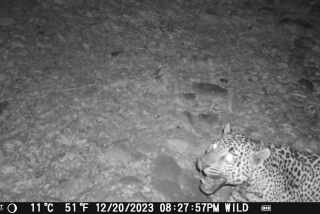ARCHEOLOGY : Arizonan Lives With Mammoths in His Back Yard : The 38-year-old find is still probed by experts, students. Spear points link man to site.
SIERRA VISTA, Ariz. — Ed Lehner’s life was turned upside down one sunny day 38 years ago, as he hiked into a dry wash about 100 yards behind the ranch house he was buying.
There, in a secluded corner of southern Arizona between the Huachuca and Mule mountains, he spotted a layer of strange black soil along the bottom of the cutbank. Protruding from the soil were bones too big to be remains of a horse or cow.
After more inspection, Lehner found the tooth plate of a mammoth, a prehistoric elephant. “I recognized it right away because a fair portion of my youth was misspent in museums and studying Indian ruins,” said Lehner, 76.
The discovery led him to Emil Haury, an archeologist at the University of Arizona who was digging in Naco, Ariz., 12 miles to the southeast. About a year earlier, mammoth bones had been unearthed there.
Haury confirmed Lehner’s opinion that the tooth plate and bones were remains of an animal that had roamed the area 12,000 years ago.
It wasn’t until three years later, after five days of rain sent torrents of water through the wash, that Lehner and Haury realized what an extraordinary find they had made.
“When the storm cleared, I went out, and where there had only been a few feet of bone showing before, now there were 100 feet,” Lehner said.
That year, excavations turned up spear points--proof that early man had hunted the huge animals, probably as they watered at what had been a stream.
Haury said the find is significant because, along with the Naco mammoth site, it shows that man and mammoth were contemporary in Arizona. “The discovery gave us proof beyond a doubt,” he said.
Since then, there have been other digs, including a National Geographic study that Lehner says turned up evidence of many species.
One scientist told Lehner that his back yard could contain the largest assortment of extinct animals ever found.
Thus far, diggers have discovered 13 spear points, a variety of stone butchering tools, charcoal from fires and the remains of bison, camels, horses, American lions, mastodons, tapirs, bears, wolves of three types and the lower jawbones of 12 mammoths.
“The tooth part preserves better, and most of the rest of the animal was taken away for its food,” Lehner said. “ . . . . This was a kill site.”
The New York native and retired ecologist for the Phelps Dodge Corp., a copper-mining company, has served as a kind of unofficial tour guide and promoter of the site. Even though Lehner calls himself “the Cochise County curmudgeon,” he is delighted by the unending stream of attention and visitors the find has attracted.
“I’ve always been interested in the natural world,” said Lehner, who did graduate work in ornithology and animal husbandry at Cornell University.
Scientists from every continent have studied the site. Some weeks, schoolchildren by the hundreds roll up in buses. Graduate seminars often take place there.
Lehner’s wife, Lyn, 71, remembers peering through a window and seeing rows of military-style pup tents, which house students during digs.
“We’re so far off the track that only people who are really interested come by,” said Mrs. Lehner, who often has to shoo a dozen or so wild javelina off her patio in the morning.
In 1967, the Lehner Mammoth Kill Site was made a national historic landmark, and, two years ago, the couple donated six acres of the site to the federal Bureau of Land Management.
Lehner said he would be more delighted than surprised if some bones of the hunters themselves are discovered.
“Wouldn’t that be the wildest thing of all?” he said, gazing across the broad valley.
More to Read
Sign up for Essential California
The most important California stories and recommendations in your inbox every morning.
You may occasionally receive promotional content from the Los Angeles Times.










